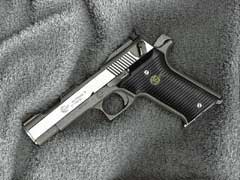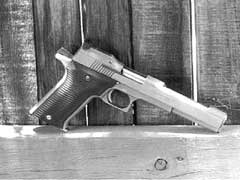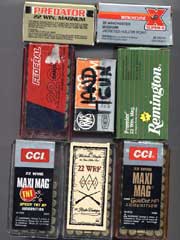|
It wasn't very long
ago that some very well-designed little .22 Magnum handguns
were available from AMT (Arcadia Machine & Tool)
of Irwindale, CA.
The two auto handguns
pictured in the accompanying photos, the 4" barreled
version and the 6" barreled version, were purchased
years ago. These guns, along with a 2" barreled
version, were still listed in the 2000 Guns & Ammo
Annual, but they had unfortunately disappeared by the time
the 2001 G&A Annual was published.
You
won't find too many auto-loading .22 Magnum handguns on the
market because of the difficulty in the blowback systems
typically seen in auto-loading rimfires. The extra pressure
of the .22 Magnum requires a very heavy and bulky slide as
an inertial damper, but AMT wanted to keep their guns slim,
trim, attractive and appealing. SO to overcome the problem
of blowback before the bullet leaves the barrel, AMT showed
a little bit of design genius...
The AutoMag II's
chamber has a series of small indents in its chamber walls.
Upon firing, the cartridge case expands into the indents as
well as against the chamber wall, thus gripping the wall of
the chamber. By the time the chamber wall has been released
by the brass' "memory" springing back to its
normal state, the bullet has left the barrel, pressure has
dropped to a safe level, and the ejection cycle continues as
normal. AMT always explained in their user manuals,
"USE ONLY .22 WINCHESTER MAGNUM RIMFIRE AMMO".
When
the AutoMag II first hit the market, CCI .22WMR ammo
wouldn't completely activate the slide in the ejection
cycle. This would cause jams. Winchester brand ammo did not
exhibit this problem, which probably resulted from
differences in the brass recipe used in the cartridge cases.
These problems were rectified in a very few years, and CCI
ammo, as well as Winchester and several other makes, now
cycles just fine in my two guns.
The
4" barrel model is actually a bit more than that if
measured from the breech face with an empty chamber.
Dropping a measuring rod down the barrel (after
double-checking that the gun was not loaded!) yielded a
measurement of 4.57", which would drop to a bit less
than 4" from the nose of the bullet once the gun is
loaded.
But
in truth, we should measure to the mouth of a fired
cartridge case, because the pressure begins at the base of
the bullet, not the nose. With revolvers, the
"real" barrel length, as far as pressure is
concerned, is from the mouth of the cartridge in the
cylinder's chamber all the way to the muzzle of the barrel.
So,
measured in this way, the AMT's barrel is actually very
close to its advertised 4" length. Plus it is a
"closed chamber", unlike a revolver which has a barrel/cylinder
gap that drops 50-60 feet per second of muzzle velocity for
each 1/1000th of an inch in the gap. For comparison,
centerfire cartridges such as the 9mm, .40 S&W, and 10mm
Auto lose nearly 100 feet per second for every 1/1000th of
gap.
The
AMT AutoMag II's slide is 0.791" wide, or just a little
over 3/4" of an inch. The grips are just slightly over
1" wide. The average .45 ACP autoloader's slide is an
inch wide, and the grip almost an inch and a half. Overall,
the 4" AutoMag II is 7" long and 4.8" high.
Small,
slim and light to carry, with a nasty bite. Except for grips and
springs, the AutoMag II is made entirely from stainless steel.
Even the magazine, which holds nine rounds (allowing a total
capacity of ten rounds including one in the chamber) is made
from stainless steel. The AutoMag II features an excellent
hammer block safety, almost Ellison-like adjustable rear sight,
and an outstanding ramp front sight.
With
most magnum handgun cartridges, there is about a 300-400 fps
velocity drop as compared to the same round fired from a
rifle, and the .22 Magnum is no exception. Winchester's
40-grain Hollowpoint gives 1903 from my 24-inch CZ rifle;
the same ammo from my six-inch AMT clocks 1442 fps, and the
four-inch AMT gives 1333 fps.
Rimfire
magnum ammo is somewhat strange: it's all over the place in
bullet weight, velocities and bullet strength. As an
example, for years Winchester used a slow-burning powder in
the .22 WMR because the thinking at the big red
"W" was, "It's a rifle cartridge".
Likewise, CCI used faster-burning powder because they
thought of the .22 WMR as a handgun cartridge.
It
was Ruger that finally debunked the idea that the .22 WMR was a
"rifle-only" cartridge with their wonderful Single-Six
with dual .22 LR and .22 WMR cylinders. Up until that time it
was only CCI and Winchester with hollowpoint and solid-bullet
offerings, but the round I once referred to in an article as
"the sleeper" has awakened in the minds of the
shooting public and the ammo companies.
As shown in the
accompanying picture, there are seven different selections
from six different manufacturers, and that's only a small
sample of what's available. Some .22 WMR ammo, like CCI's
TNT Maxi-Mag, features an extremely explosive bullet design
and is tailored more for vermin and pests than for small
game. On the other end of the spectrum, some feature
extremely tough bullet designs, such as CCI's Golden Hollow
Point load, which is loaded with Gold Dot bullets; I have
not cut one of these open yet, but I suspect they are solid
soft copper with a punched hollow point. Loads such as these
are excellent for small game up to javelina and coyotes. Of
course, coyotes get hit with everything, whether it's
frangible or not!
Remington's
Premier ammo has a rounded pointy bullet with a small soft
point. Predators have a soft point and a flat tip; this is a
jacketed bullet, not a copper-washed bullet, with a large
soft flat nose. And of course, all the ammo companies make
solids as well as hollowpoint designs. Federal even
has an all-lead 50-grain low-velocity load (about 1450 fps
from a rifle) for squirrels and such. And much, much more.
I
carried RWS (Dynamit-Nobel) European .22 WMR ammo for
self-defense when I carried the little AutoMag II off-duty or
in the woods and such. It left the barrel of my six-inch gun
at an amazing (for then) 1550 fps and 213 pounds of muzzle
punch. One day an idiot pulled a knife on me when I informed
him that he was under arrest; I put the AMT to his kneecap and
pulled the trigger. He fell down and cried for momma, poor
baby. The State gave him free room and board for fifteen
years, and he gave up dancing forever. But
RWS ammo is expensive, so I now go with the CCI Gold Dot. It
does just as well, if not better, with its 1525 fps from the
6" AMT.
But to put it in
perspective, the .22 WMR from a rifle is much closer to the
.22 Hornet than it is between the Hornet and the standard .22
LR high-velocity round. So from a handgun with a four-inch or
longer barrel, the .22 WMR will give the same or more velocity
than a high-velocity .22 LR will give from a rifle!
The
.17s may be all the rage today, but it's the .22 Magnums and
their heavier bullets that will bring home the bacon.
Paco
Kelly
UPDATE!
The
AutoMag is back! They are now being produced by High
Standard in either 4-1/2" or 6" barrel length.
Check them out at www.highstandard.com.
  
Got something to say about this article? Want to agree (or
disagree) with it? Click the following link to go to the GUNBlast Feedback Page.
|
|
Click pictures for a larger version.


AMT's AutoMag II .22 Magnum pistol.

The .22 Magnum, or .22 WMR (Winchester Magnum Rimfire)
has a wide variety of quality factory ammunition available,
including the small sample shown here. The .22 Magnum is still
a very effective round for a variety of uses, from target
shooting to vermin shooting to small-game hunting and even
self-defense, and the AMT AutoMag II was one of the finest .22
Magnum handguns ever produced.
|
![]()